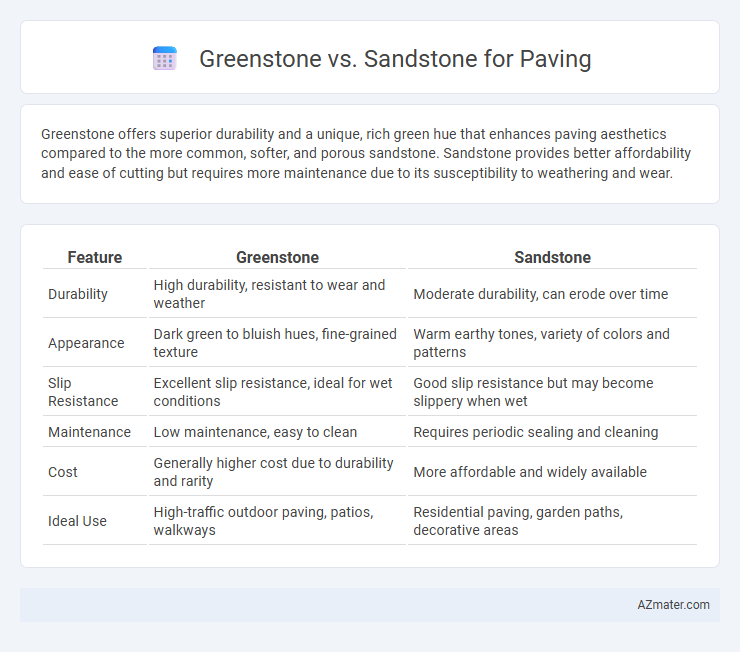Greenstone offers superior durability and a unique, rich green hue that enhances paving aesthetics compared to the more common, softer, and porous sandstone. Sandstone provides better affordability and ease of cutting but requires more maintenance due to its susceptibility to weathering and wear.
Table of Comparison
| Feature | Greenstone | Sandstone |
|---|---|---|
| Durability | High durability, resistant to wear and weather | Moderate durability, can erode over time |
| Appearance | Dark green to bluish hues, fine-grained texture | Warm earthy tones, variety of colors and patterns |
| Slip Resistance | Excellent slip resistance, ideal for wet conditions | Good slip resistance but may become slippery when wet |
| Maintenance | Low maintenance, easy to clean | Requires periodic sealing and cleaning |
| Cost | Generally higher cost due to durability and rarity | More affordable and widely available |
| Ideal Use | High-traffic outdoor paving, patios, walkways | Residential paving, garden paths, decorative areas |
Introduction to Greenstone and Sandstone Paving
Greenstone and sandstone are popular choices for paving due to their durability and aesthetic appeal. Greenstone, a dense, fine-grained metamorphic rock, offers superior strength and a distinctive greenish hue, making it ideal for high-traffic areas. Sandstone, a sedimentary rock characterized by its granular texture and warm earthy tones, provides excellent slip resistance and a natural, rustic look suitable for both patios and pathways.
Key Characteristics of Greenstone
Greenstone is a dense, durable igneous rock known for its fine-grained texture and smooth surface, making it highly resistant to wear and weathering compared to sandstone. Its natural dark green to bluish-green hues provide a unique aesthetic ideal for modern and rustic paving designs. Greenstone's high compressive strength and low porosity ensure long-lasting, slip-resistant pavements suitable for both pedestrian and vehicular traffic.
Key Characteristics of Sandstone
Sandstone is a durable sedimentary rock composed mainly of quartz and feldspar, characterized by its natural grainy texture and variety of earthy hues like beige, red, and brown. Its porosity allows for good drainage, making it a practical choice for outdoor paving in diverse climates. Sandstone's slip-resistant surface and weather-resistant properties ensure safety and longevity in garden paths, patios, and driveways.
Durability Comparison: Greenstone vs Sandstone
Greenstone offers superior durability compared to sandstone due to its higher density and resistance to wear, making it ideal for high-traffic paving areas. Sandstone, while aesthetically appealing, is more porous and susceptible to erosion and weathering, requiring more maintenance over time. The intrinsic hardness of greenstone significantly outperforms sandstone in withstanding heavy loads and environmental stress.
Aesthetic Differences in Paving Design
Greenstone offers a unique, rich green hue with subtle veining that creates a striking, natural aesthetic in paving designs, often preferred for its elegant and earthy appearance. Sandstone exhibits warm, earthy tones ranging from soft beige to deep rust, providing a classic and versatile look that blends seamlessly with various architectural styles. The choice between greenstone and sandstone significantly impacts the visual appeal, with greenstone delivering bold color contrast and sandstone offering timeless warmth and texture.
Maintenance Requirements for Each Stone
Greenstone requires minimal maintenance due to its dense, non-porous structure, which resists staining and weathering, making it ideal for high-traffic paving areas. Sandstone, being more porous, demands regular sealing to prevent moisture absorption and staining, alongside frequent cleaning to avoid surface erosion. Proper maintenance of sandstone involves scheduled resealing every 1-2 years, while greenstone's durability significantly reduces upkeep costs over time.
Cost Analysis: Greenstone vs Sandstone
Greenstone typically costs more than sandstone due to its durability and rarity, impacting project budgets significantly. Sandstone is more affordable and widely available, offering good value for large-scale paving but may require more maintenance over time. Choosing between greenstone and sandstone depends on balancing upfront costs with long-term durability and appearance considerations.
Environmental Impact and Sustainability
Greenstone offers a lower environmental impact compared to sandstone due to its natural abundance and minimal processing requirements, reducing carbon emissions during extraction and manufacture. Sandstone often requires more intensive quarrying and energy consumption, leading to greater habitat disruption and a larger carbon footprint. Choosing greenstone for paving enhances sustainability by promoting resource efficiency and longer-lasting durability in outdoor applications.
Best Use Cases for Greenstone and Sandstone
Greenstone is ideal for paving projects requiring exceptional durability and a polished, dark green aesthetic, making it a preferred choice for commercial walkways and high-traffic areas. Sandstone, known for its warm earth tones and natural slip resistance, excels in residential patios and garden paths where a rustic, inviting atmosphere is desired. Both stones offer weather resistance, but greenstone's hardness suits it better for heavy-use zones, while sandstone's varied textures complement softer landscaping designs.
Which Stone is Best for Your Paving Project?
Greenstone offers enhanced durability and resistance to weathering, making it ideal for high-traffic paving areas, while sandstone provides a softer, more textured surface perfect for decorative and landscaping projects. Sandstone's natural variety of colors and ease of cutting allow for intricate designs, whereas greenstone's dense composition ensures longevity and minimal maintenance. Choosing the best stone depends on the project's aesthetic goals and functional requirements, with greenstone preferred for strength and sandstone favored for visual appeal.

Infographic: Greenstone vs Sandstone for Paving
 azmater.com
azmater.com